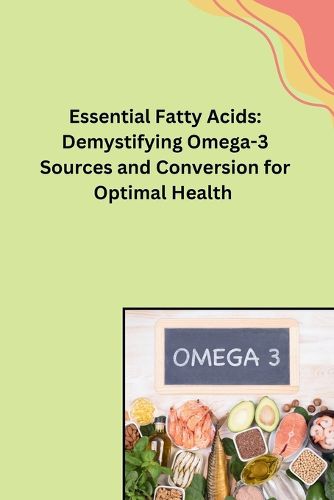Readings Newsletter
Become a Readings Member to make your shopping experience even easier.
Sign in or sign up for free!
You’re not far away from qualifying for FREE standard shipping within Australia
You’ve qualified for FREE standard shipping within Australia
The cart is loading…






This title is printed to order. This book may have been self-published. If so, we cannot guarantee the quality of the content. In the main most books will have gone through the editing process however some may not. We therefore suggest that you be aware of this before ordering this book. If in doubt check either the author or publisher’s details as we are unable to accept any returns unless they are faulty. Please contact us if you have any questions.
This title delves into the world of essential fatty acids, specifically focusing on the crucial role of omega-3s in maintaining good health. The description aims to demystify the sources and conversion of these essential fats, empowering individuals to make informed dietary choices.Firstly, it establishes essential fatty acids as vital nutrients our bodies cannot produce on their own, emphasizing the need to obtain them through our diet. The description then focuses on omega-3s, highlighting their specific benefits for various bodily functions, including brain health, heart health, and reducing inflammation.However, the description acknowledges the complexity surrounding omega-3s, particularly regarding their sources and conversion. It explains the presence of different types of omega-3s: alpha-linolenic acid (ALA), eicosapentaenoic acid (EPA), and docosahexaenoic acid (DHA). ALA is found primarily in plant-based sources like flaxseed and chia seeds, while EPA and DHA are predominantly found in fatty fish and fish oil.Crucially, the description clarifies that our bodies can convert ALA into EPA and DHA, albeit at a limited rate. This emphasizes the importance of directly consuming EPA and DHA, especially from fatty fish sources, to ensure optimal levels and reap their full health benefits.By demystifying the sources and conversion of omega-3s, the description empowers individuals to make informed choices about incorporating them into their diet. It encourages exploring both plant-based and fish-based sources while acknowledging that direct consumption of EPA and DHA from fatty fish might be more efficient in achieving optimal health
$9.00 standard shipping within Australia
FREE standard shipping within Australia for orders over $100.00
Express & International shipping calculated at checkout
This title is printed to order. This book may have been self-published. If so, we cannot guarantee the quality of the content. In the main most books will have gone through the editing process however some may not. We therefore suggest that you be aware of this before ordering this book. If in doubt check either the author or publisher’s details as we are unable to accept any returns unless they are faulty. Please contact us if you have any questions.
This title delves into the world of essential fatty acids, specifically focusing on the crucial role of omega-3s in maintaining good health. The description aims to demystify the sources and conversion of these essential fats, empowering individuals to make informed dietary choices.Firstly, it establishes essential fatty acids as vital nutrients our bodies cannot produce on their own, emphasizing the need to obtain them through our diet. The description then focuses on omega-3s, highlighting their specific benefits for various bodily functions, including brain health, heart health, and reducing inflammation.However, the description acknowledges the complexity surrounding omega-3s, particularly regarding their sources and conversion. It explains the presence of different types of omega-3s: alpha-linolenic acid (ALA), eicosapentaenoic acid (EPA), and docosahexaenoic acid (DHA). ALA is found primarily in plant-based sources like flaxseed and chia seeds, while EPA and DHA are predominantly found in fatty fish and fish oil.Crucially, the description clarifies that our bodies can convert ALA into EPA and DHA, albeit at a limited rate. This emphasizes the importance of directly consuming EPA and DHA, especially from fatty fish sources, to ensure optimal levels and reap their full health benefits.By demystifying the sources and conversion of omega-3s, the description empowers individuals to make informed choices about incorporating them into their diet. It encourages exploring both plant-based and fish-based sources while acknowledging that direct consumption of EPA and DHA from fatty fish might be more efficient in achieving optimal health